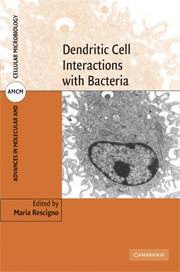Book contents
- Frontmatter
- Contents
- Preface
- List of Abbreviations
- List of Contributors
- I Dendritic cells and their role in immunity
- II Dendritic cells and innate immune responses to bacteria
- III Dendritic cells and adaptive immune responses to bacteria
- 7 Peculiar ability of dendritic cells to process and present antigens from vacuolar pathogens: a lesson from Legionella
- 8 Dendritic cells, macrophages and cross-presentation of bacterial antigens: a lesson from Salmonella
- IV Dendritic cells and immune evasion of bacteria in vivo
- Index
- Plate section
- References
8 - Dendritic cells, macrophages and cross-presentation of bacterial antigens: a lesson from Salmonella
from III - Dendritic cells and adaptive immune responses to bacteria
Published online by Cambridge University Press: 12 August 2009
- Frontmatter
- Contents
- Preface
- List of Abbreviations
- List of Contributors
- I Dendritic cells and their role in immunity
- II Dendritic cells and innate immune responses to bacteria
- III Dendritic cells and adaptive immune responses to bacteria
- 7 Peculiar ability of dendritic cells to process and present antigens from vacuolar pathogens: a lesson from Legionella
- 8 Dendritic cells, macrophages and cross-presentation of bacterial antigens: a lesson from Salmonella
- IV Dendritic cells and immune evasion of bacteria in vivo
- Index
- Plate section
- References
Summary
INTRODUCTION
Immunity to a bacterial pathogen requires the generation of bacteria-specific T cells with appropriate effector function. Eliciting T cells during infection requires internalization of the bacteria and processing of bacterial proteins to generate peptides for presentation on major histocompatibility complex (MHC) class I (MHC-I) and/or MHC class II (MHC-II) molecules, depending on the pathogen. As not all host cells have the capacity to phagocytose bacteria, and not all bacterial pathogens have the capacity to actively invade non-phagocytic cells, phagocytic antigen presenting cells, macrophages and immature dendritic cells (DCs), are the key players in generating adaptive immunity to bacteria.
Both macrophages and immature dendritic cells can present antigens from the bacteria they internalize on their own MHC-I and MHC-II molecules and thus carry out so-called direct presentation of bacterial antigens (Sundquist et al., 2004; Harding et al., 2003). Direct presentation of bacterial antigens on MHC-II is the expected outcome following phagocytosis of bacteria and is the event necessary to elicit CD4+ T cells. However, both macrophages and DCs can also present antigens from internalized bacteria on MHC-I, molecules most renowned for their presentation of peptides derived from endogenously synthesized proteins (Rock and Goldberg, 1999), and generate CD8+ T cells (Sundquist et al., 2004; Harding et al., 2003).
Given the capacity of both macrophages and DCs to directly present bacterial antigens on MHC-I and MHC-II, these cells in principle could initiate adaptive immunity during primary infection. However, it is only DCs that have this ability (Banchereau and Steinman, 1998).
Information
- Type
- Chapter
- Information
- Dendritic Cell Interactions with Bacteria , pp. 159 - 170Publisher: Cambridge University PressPrint publication year: 2007
